A Cultural Analysis of Norway: Health, Family, and Death
VerifiedAdded on 2021/04/21
|12
|2795
|35
Essay
AI Summary
This essay provides a comprehensive cultural analysis of Norway, exploring various facets of its society. The analysis begins with an examination of health beliefs and practices, highlighting Norway's high health standards, modern medical approaches, and the role of alternative medicines. The essay then delves into family patterns, discussing gender roles, generational gaps, marriage, and child-rearing practices. The communication style of Norwegians is also explored, emphasizing their directness, honesty, and preference for concise communication. Finally, the essay examines death and dying practices, tracing the evolution of cremation and burial customs in Norway, including the influence of religious beliefs and modern advancements. The study aims to enhance the understanding of Norwegian culture, particularly for those navigating diverse cultural contexts in the workplace.
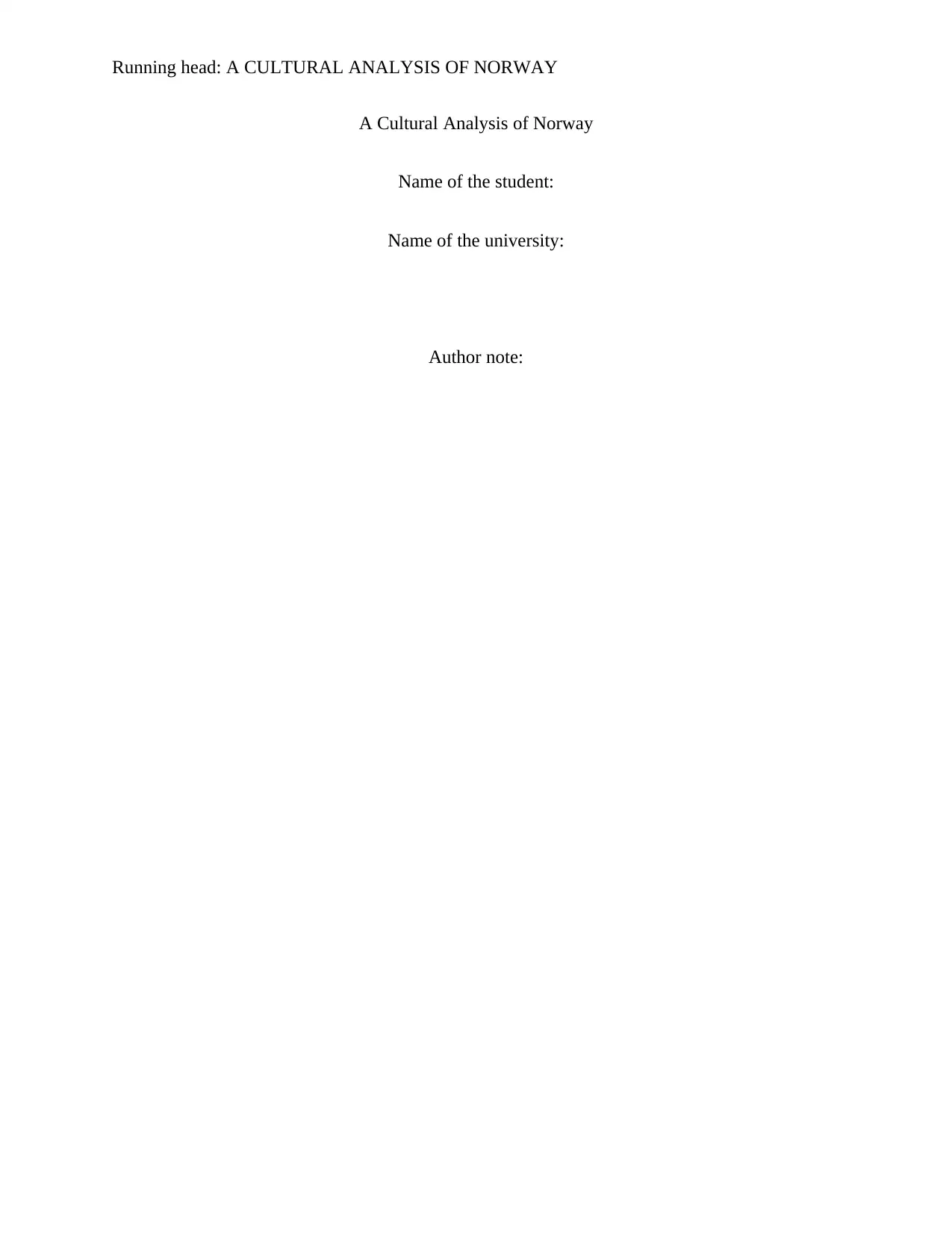
Running head: A CULTURAL ANALYSIS OF NORWAY
A Cultural Analysis of Norway
Name of the student:
Name of the university:
Author note:
A Cultural Analysis of Norway
Name of the student:
Name of the university:
Author note:
Paraphrase This Document
Need a fresh take? Get an instant paraphrase of this document with our AI Paraphraser
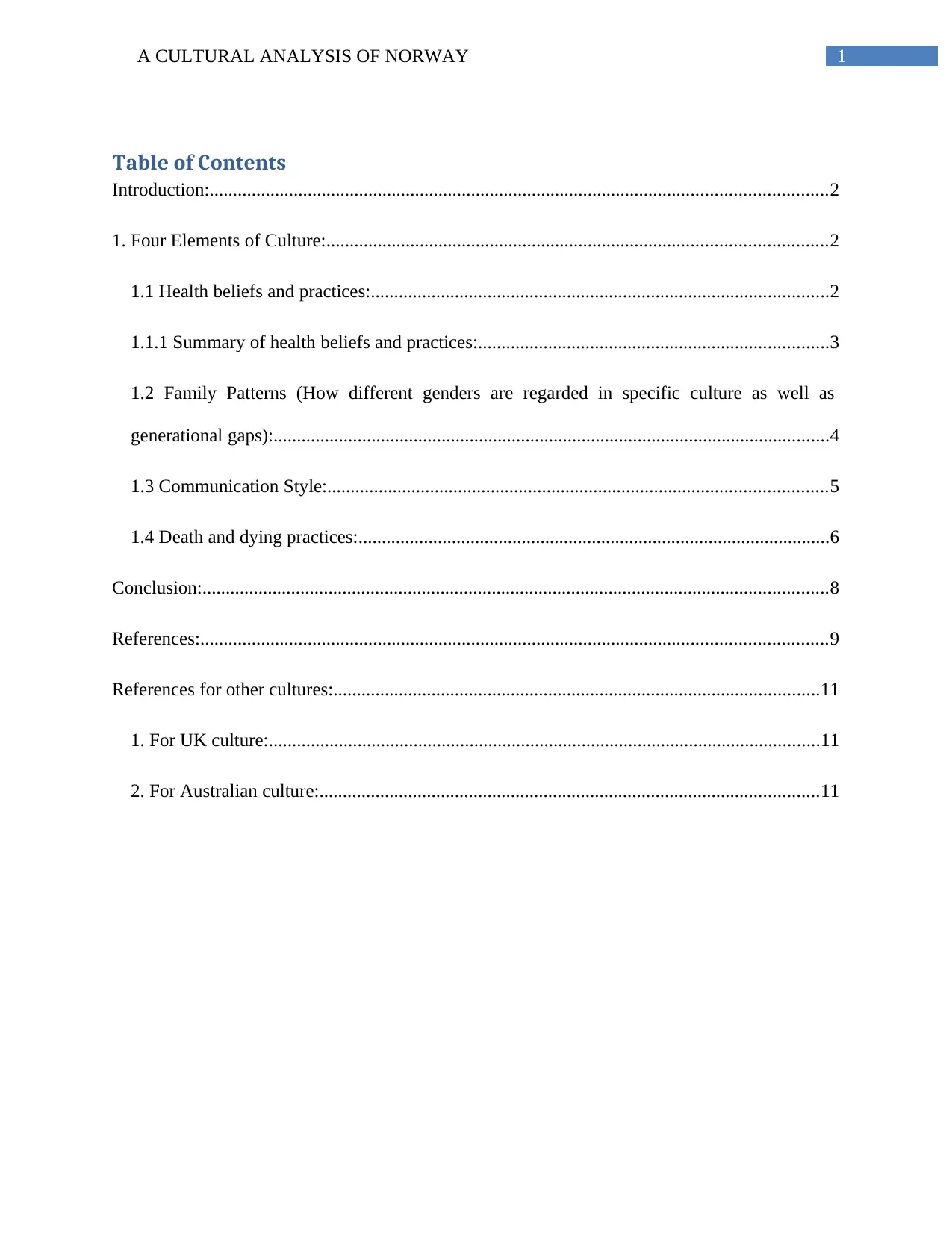
1A CULTURAL ANALYSIS OF NORWAY
Table of Contents
Introduction:....................................................................................................................................2
1. Four Elements of Culture:...........................................................................................................2
1.1 Health beliefs and practices:..................................................................................................2
1.1.1 Summary of health beliefs and practices:...........................................................................3
1.2 Family Patterns (How different genders are regarded in specific culture as well as
generational gaps):.......................................................................................................................4
1.3 Communication Style:...........................................................................................................5
1.4 Death and dying practices:.....................................................................................................6
Conclusion:......................................................................................................................................8
References:......................................................................................................................................9
References for other cultures:........................................................................................................11
1. For UK culture:......................................................................................................................11
2. For Australian culture:...........................................................................................................11
Table of Contents
Introduction:....................................................................................................................................2
1. Four Elements of Culture:...........................................................................................................2
1.1 Health beliefs and practices:..................................................................................................2
1.1.1 Summary of health beliefs and practices:...........................................................................3
1.2 Family Patterns (How different genders are regarded in specific culture as well as
generational gaps):.......................................................................................................................4
1.3 Communication Style:...........................................................................................................5
1.4 Death and dying practices:.....................................................................................................6
Conclusion:......................................................................................................................................8
References:......................................................................................................................................9
References for other cultures:........................................................................................................11
1. For UK culture:......................................................................................................................11
2. For Australian culture:...........................................................................................................11
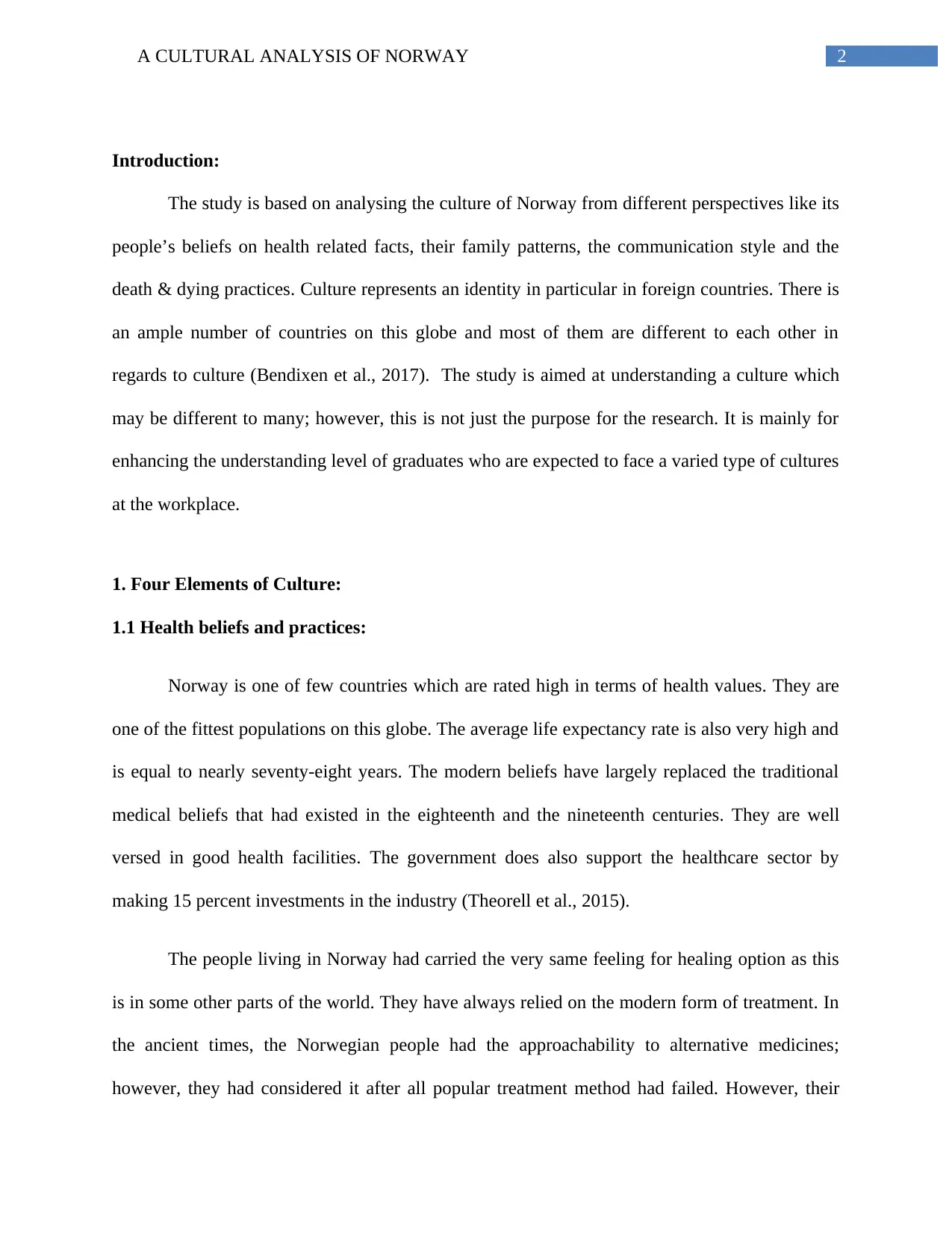
2A CULTURAL ANALYSIS OF NORWAY
Introduction:
The study is based on analysing the culture of Norway from different perspectives like its
people’s beliefs on health related facts, their family patterns, the communication style and the
death & dying practices. Culture represents an identity in particular in foreign countries. There is
an ample number of countries on this globe and most of them are different to each other in
regards to culture (Bendixen et al., 2017). The study is aimed at understanding a culture which
may be different to many; however, this is not just the purpose for the research. It is mainly for
enhancing the understanding level of graduates who are expected to face a varied type of cultures
at the workplace.
1. Four Elements of Culture:
1.1 Health beliefs and practices:
Norway is one of few countries which are rated high in terms of health values. They are
one of the fittest populations on this globe. The average life expectancy rate is also very high and
is equal to nearly seventy-eight years. The modern beliefs have largely replaced the traditional
medical beliefs that had existed in the eighteenth and the nineteenth centuries. They are well
versed in good health facilities. The government does also support the healthcare sector by
making 15 percent investments in the industry (Theorell et al., 2015).
The people living in Norway had carried the very same feeling for healing option as this
is in some other parts of the world. They have always relied on the modern form of treatment. In
the ancient times, the Norwegian people had the approachability to alternative medicines;
however, they had considered it after all popular treatment method had failed. However, their
Introduction:
The study is based on analysing the culture of Norway from different perspectives like its
people’s beliefs on health related facts, their family patterns, the communication style and the
death & dying practices. Culture represents an identity in particular in foreign countries. There is
an ample number of countries on this globe and most of them are different to each other in
regards to culture (Bendixen et al., 2017). The study is aimed at understanding a culture which
may be different to many; however, this is not just the purpose for the research. It is mainly for
enhancing the understanding level of graduates who are expected to face a varied type of cultures
at the workplace.
1. Four Elements of Culture:
1.1 Health beliefs and practices:
Norway is one of few countries which are rated high in terms of health values. They are
one of the fittest populations on this globe. The average life expectancy rate is also very high and
is equal to nearly seventy-eight years. The modern beliefs have largely replaced the traditional
medical beliefs that had existed in the eighteenth and the nineteenth centuries. They are well
versed in good health facilities. The government does also support the healthcare sector by
making 15 percent investments in the industry (Theorell et al., 2015).
The people living in Norway had carried the very same feeling for healing option as this
is in some other parts of the world. They have always relied on the modern form of treatment. In
the ancient times, the Norwegian people had the approachability to alternative medicines;
however, they had considered it after all popular treatment method had failed. However, their
⊘ This is a preview!⊘
Do you want full access?
Subscribe today to unlock all pages.

Trusted by 1+ million students worldwide
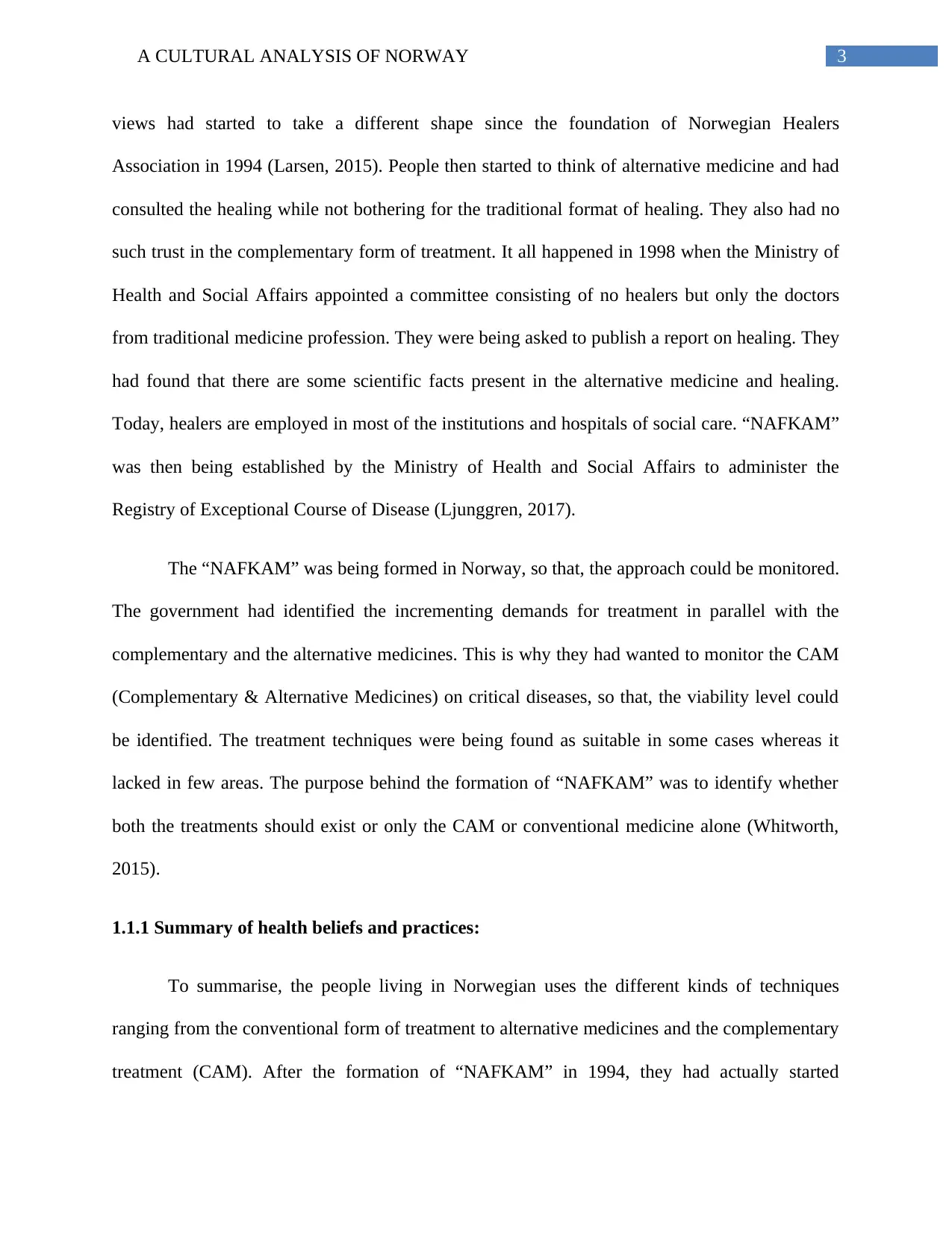
3A CULTURAL ANALYSIS OF NORWAY
views had started to take a different shape since the foundation of Norwegian Healers
Association in 1994 (Larsen, 2015). People then started to think of alternative medicine and had
consulted the healing while not bothering for the traditional format of healing. They also had no
such trust in the complementary form of treatment. It all happened in 1998 when the Ministry of
Health and Social Affairs appointed a committee consisting of no healers but only the doctors
from traditional medicine profession. They were being asked to publish a report on healing. They
had found that there are some scientific facts present in the alternative medicine and healing.
Today, healers are employed in most of the institutions and hospitals of social care. “NAFKAM”
was then being established by the Ministry of Health and Social Affairs to administer the
Registry of Exceptional Course of Disease (Ljunggren, 2017).
The “NAFKAM” was being formed in Norway, so that, the approach could be monitored.
The government had identified the incrementing demands for treatment in parallel with the
complementary and the alternative medicines. This is why they had wanted to monitor the CAM
(Complementary & Alternative Medicines) on critical diseases, so that, the viability level could
be identified. The treatment techniques were being found as suitable in some cases whereas it
lacked in few areas. The purpose behind the formation of “NAFKAM” was to identify whether
both the treatments should exist or only the CAM or conventional medicine alone (Whitworth,
2015).
1.1.1 Summary of health beliefs and practices:
To summarise, the people living in Norwegian uses the different kinds of techniques
ranging from the conventional form of treatment to alternative medicines and the complementary
treatment (CAM). After the formation of “NAFKAM” in 1994, they had actually started
views had started to take a different shape since the foundation of Norwegian Healers
Association in 1994 (Larsen, 2015). People then started to think of alternative medicine and had
consulted the healing while not bothering for the traditional format of healing. They also had no
such trust in the complementary form of treatment. It all happened in 1998 when the Ministry of
Health and Social Affairs appointed a committee consisting of no healers but only the doctors
from traditional medicine profession. They were being asked to publish a report on healing. They
had found that there are some scientific facts present in the alternative medicine and healing.
Today, healers are employed in most of the institutions and hospitals of social care. “NAFKAM”
was then being established by the Ministry of Health and Social Affairs to administer the
Registry of Exceptional Course of Disease (Ljunggren, 2017).
The “NAFKAM” was being formed in Norway, so that, the approach could be monitored.
The government had identified the incrementing demands for treatment in parallel with the
complementary and the alternative medicines. This is why they had wanted to monitor the CAM
(Complementary & Alternative Medicines) on critical diseases, so that, the viability level could
be identified. The treatment techniques were being found as suitable in some cases whereas it
lacked in few areas. The purpose behind the formation of “NAFKAM” was to identify whether
both the treatments should exist or only the CAM or conventional medicine alone (Whitworth,
2015).
1.1.1 Summary of health beliefs and practices:
To summarise, the people living in Norwegian uses the different kinds of techniques
ranging from the conventional form of treatment to alternative medicines and the complementary
treatment (CAM). After the formation of “NAFKAM” in 1994, they had actually started
Paraphrase This Document
Need a fresh take? Get an instant paraphrase of this document with our AI Paraphraser
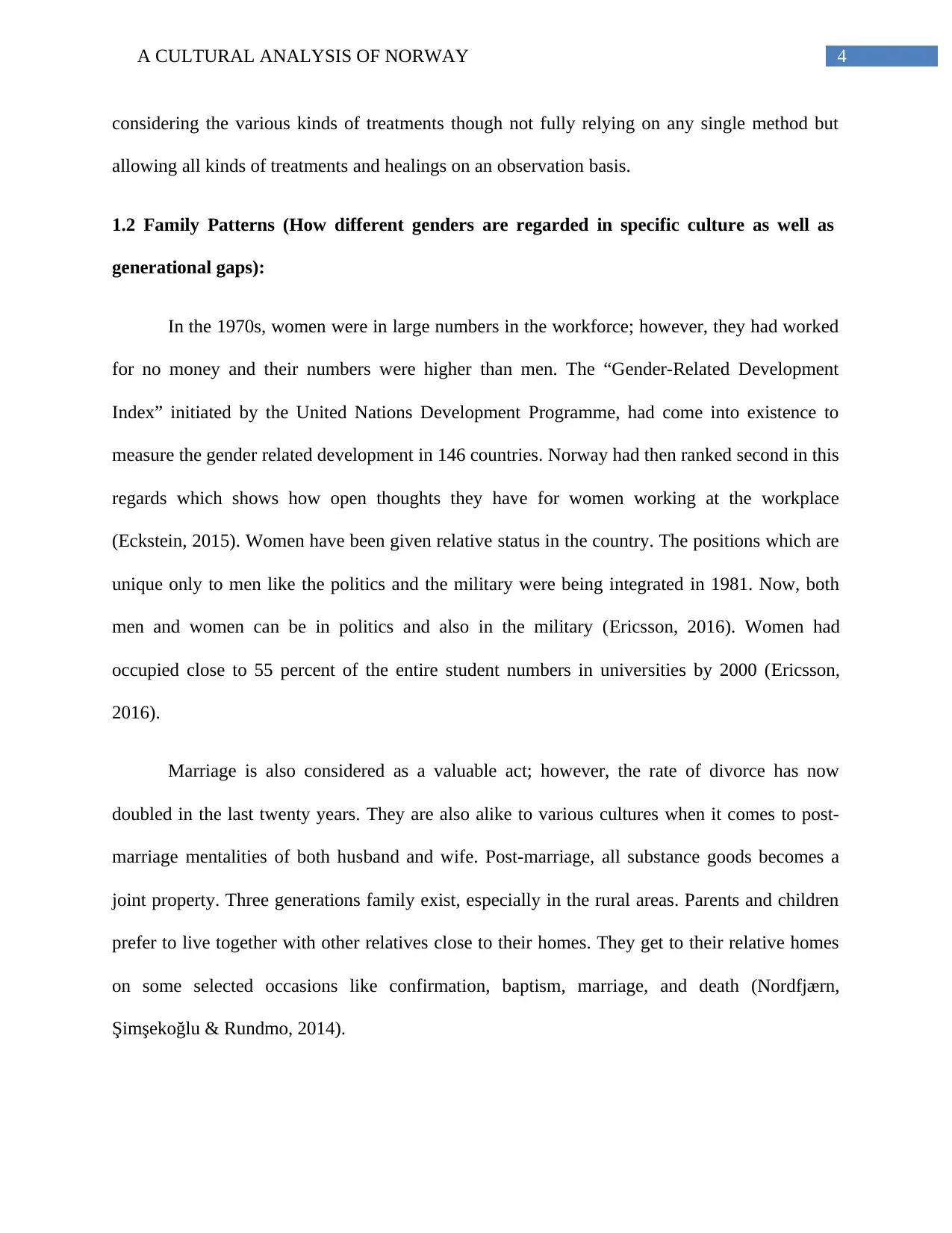
4A CULTURAL ANALYSIS OF NORWAY
considering the various kinds of treatments though not fully relying on any single method but
allowing all kinds of treatments and healings on an observation basis.
1.2 Family Patterns (How different genders are regarded in specific culture as well as
generational gaps):
In the 1970s, women were in large numbers in the workforce; however, they had worked
for no money and their numbers were higher than men. The “Gender-Related Development
Index” initiated by the United Nations Development Programme, had come into existence to
measure the gender related development in 146 countries. Norway had then ranked second in this
regards which shows how open thoughts they have for women working at the workplace
(Eckstein, 2015). Women have been given relative status in the country. The positions which are
unique only to men like the politics and the military were being integrated in 1981. Now, both
men and women can be in politics and also in the military (Ericsson, 2016). Women had
occupied close to 55 percent of the entire student numbers in universities by 2000 (Ericsson,
2016).
Marriage is also considered as a valuable act; however, the rate of divorce has now
doubled in the last twenty years. They are also alike to various cultures when it comes to post-
marriage mentalities of both husband and wife. Post-marriage, all substance goods becomes a
joint property. Three generations family exist, especially in the rural areas. Parents and children
prefer to live together with other relatives close to their homes. They get to their relative homes
on some selected occasions like confirmation, baptism, marriage, and death (Nordfjærn,
Şimşekoğlu & Rundmo, 2014).
considering the various kinds of treatments though not fully relying on any single method but
allowing all kinds of treatments and healings on an observation basis.
1.2 Family Patterns (How different genders are regarded in specific culture as well as
generational gaps):
In the 1970s, women were in large numbers in the workforce; however, they had worked
for no money and their numbers were higher than men. The “Gender-Related Development
Index” initiated by the United Nations Development Programme, had come into existence to
measure the gender related development in 146 countries. Norway had then ranked second in this
regards which shows how open thoughts they have for women working at the workplace
(Eckstein, 2015). Women have been given relative status in the country. The positions which are
unique only to men like the politics and the military were being integrated in 1981. Now, both
men and women can be in politics and also in the military (Ericsson, 2016). Women had
occupied close to 55 percent of the entire student numbers in universities by 2000 (Ericsson,
2016).
Marriage is also considered as a valuable act; however, the rate of divorce has now
doubled in the last twenty years. They are also alike to various cultures when it comes to post-
marriage mentalities of both husband and wife. Post-marriage, all substance goods becomes a
joint property. Three generations family exist, especially in the rural areas. Parents and children
prefer to live together with other relatives close to their homes. They get to their relative homes
on some selected occasions like confirmation, baptism, marriage, and death (Nordfjærn,
Şimşekoğlu & Rundmo, 2014).
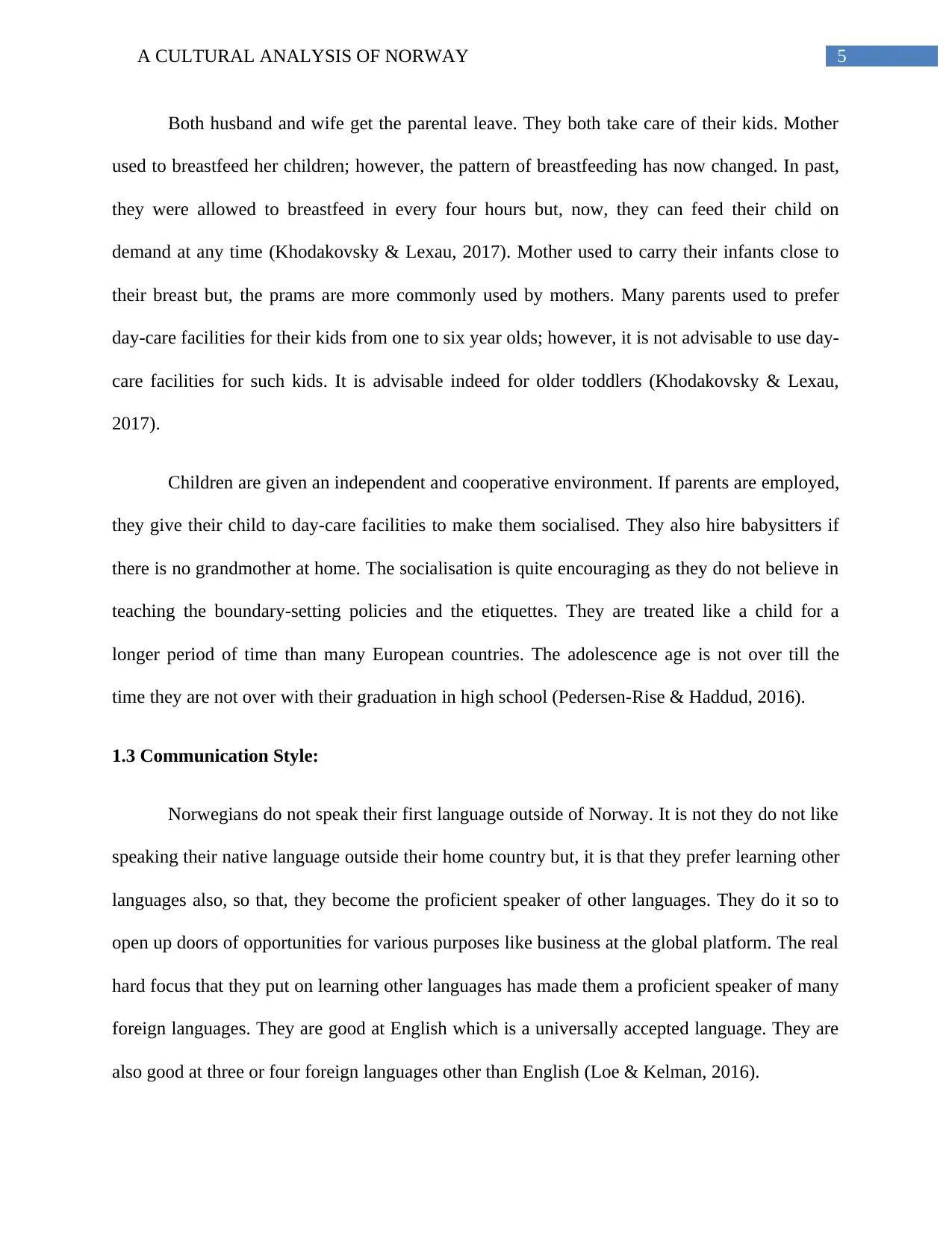
5A CULTURAL ANALYSIS OF NORWAY
Both husband and wife get the parental leave. They both take care of their kids. Mother
used to breastfeed her children; however, the pattern of breastfeeding has now changed. In past,
they were allowed to breastfeed in every four hours but, now, they can feed their child on
demand at any time (Khodakovsky & Lexau, 2017). Mother used to carry their infants close to
their breast but, the prams are more commonly used by mothers. Many parents used to prefer
day-care facilities for their kids from one to six year olds; however, it is not advisable to use day-
care facilities for such kids. It is advisable indeed for older toddlers (Khodakovsky & Lexau,
2017).
Children are given an independent and cooperative environment. If parents are employed,
they give their child to day-care facilities to make them socialised. They also hire babysitters if
there is no grandmother at home. The socialisation is quite encouraging as they do not believe in
teaching the boundary-setting policies and the etiquettes. They are treated like a child for a
longer period of time than many European countries. The adolescence age is not over till the
time they are not over with their graduation in high school (Pedersen-Rise & Haddud, 2016).
1.3 Communication Style:
Norwegians do not speak their first language outside of Norway. It is not they do not like
speaking their native language outside their home country but, it is that they prefer learning other
languages also, so that, they become the proficient speaker of other languages. They do it so to
open up doors of opportunities for various purposes like business at the global platform. The real
hard focus that they put on learning other languages has made them a proficient speaker of many
foreign languages. They are good at English which is a universally accepted language. They are
also good at three or four foreign languages other than English (Loe & Kelman, 2016).
Both husband and wife get the parental leave. They both take care of their kids. Mother
used to breastfeed her children; however, the pattern of breastfeeding has now changed. In past,
they were allowed to breastfeed in every four hours but, now, they can feed their child on
demand at any time (Khodakovsky & Lexau, 2017). Mother used to carry their infants close to
their breast but, the prams are more commonly used by mothers. Many parents used to prefer
day-care facilities for their kids from one to six year olds; however, it is not advisable to use day-
care facilities for such kids. It is advisable indeed for older toddlers (Khodakovsky & Lexau,
2017).
Children are given an independent and cooperative environment. If parents are employed,
they give their child to day-care facilities to make them socialised. They also hire babysitters if
there is no grandmother at home. The socialisation is quite encouraging as they do not believe in
teaching the boundary-setting policies and the etiquettes. They are treated like a child for a
longer period of time than many European countries. The adolescence age is not over till the
time they are not over with their graduation in high school (Pedersen-Rise & Haddud, 2016).
1.3 Communication Style:
Norwegians do not speak their first language outside of Norway. It is not they do not like
speaking their native language outside their home country but, it is that they prefer learning other
languages also, so that, they become the proficient speaker of other languages. They do it so to
open up doors of opportunities for various purposes like business at the global platform. The real
hard focus that they put on learning other languages has made them a proficient speaker of many
foreign languages. They are good at English which is a universally accepted language. They are
also good at three or four foreign languages other than English (Loe & Kelman, 2016).
⊘ This is a preview!⊘
Do you want full access?
Subscribe today to unlock all pages.

Trusted by 1+ million students worldwide
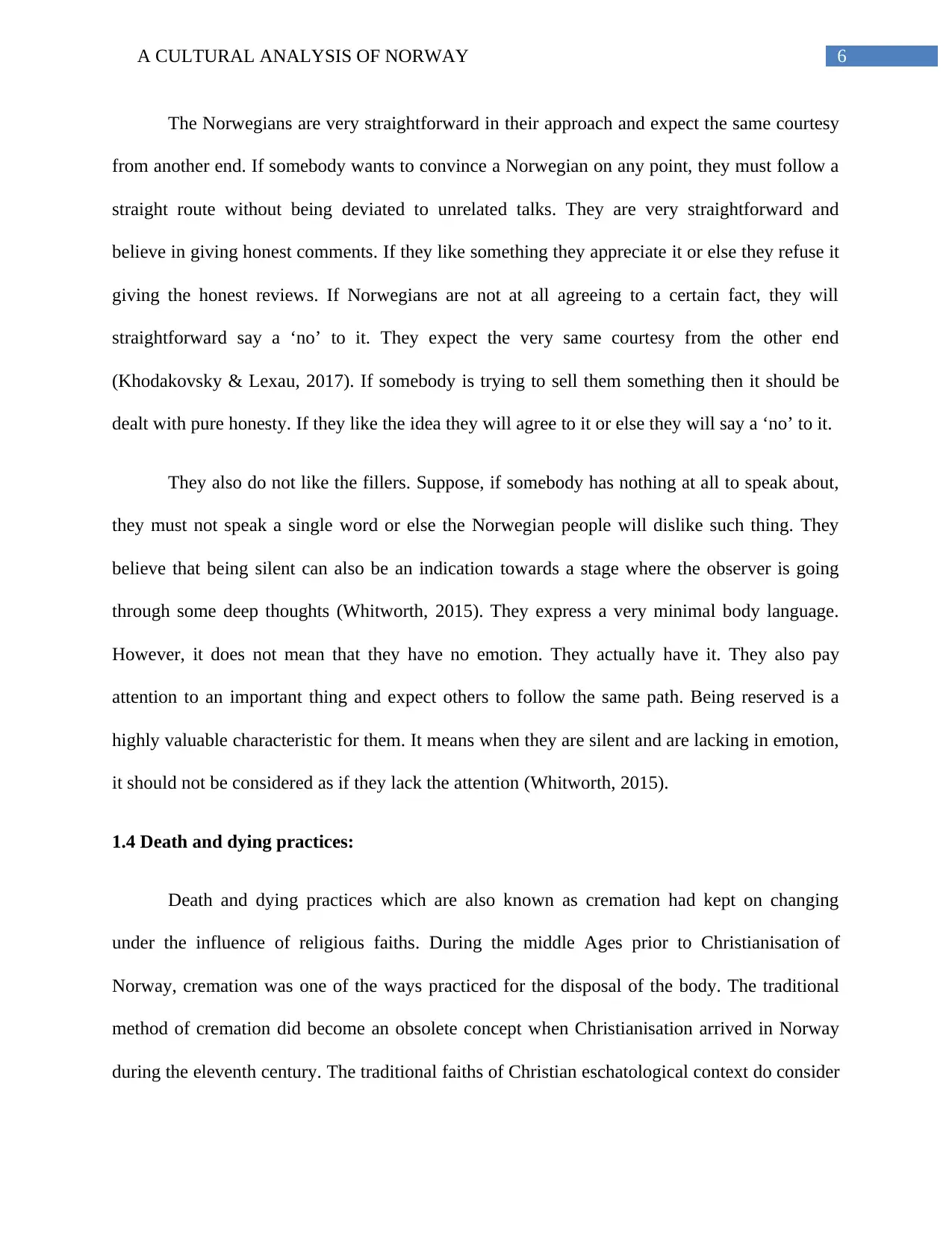
6A CULTURAL ANALYSIS OF NORWAY
The Norwegians are very straightforward in their approach and expect the same courtesy
from another end. If somebody wants to convince a Norwegian on any point, they must follow a
straight route without being deviated to unrelated talks. They are very straightforward and
believe in giving honest comments. If they like something they appreciate it or else they refuse it
giving the honest reviews. If Norwegians are not at all agreeing to a certain fact, they will
straightforward say a ‘no’ to it. They expect the very same courtesy from the other end
(Khodakovsky & Lexau, 2017). If somebody is trying to sell them something then it should be
dealt with pure honesty. If they like the idea they will agree to it or else they will say a ‘no’ to it.
They also do not like the fillers. Suppose, if somebody has nothing at all to speak about,
they must not speak a single word or else the Norwegian people will dislike such thing. They
believe that being silent can also be an indication towards a stage where the observer is going
through some deep thoughts (Whitworth, 2015). They express a very minimal body language.
However, it does not mean that they have no emotion. They actually have it. They also pay
attention to an important thing and expect others to follow the same path. Being reserved is a
highly valuable characteristic for them. It means when they are silent and are lacking in emotion,
it should not be considered as if they lack the attention (Whitworth, 2015).
1.4 Death and dying practices:
Death and dying practices which are also known as cremation had kept on changing
under the influence of religious faiths. During the middle Ages prior to Christianisation of
Norway, cremation was one of the ways practiced for the disposal of the body. The traditional
method of cremation did become an obsolete concept when Christianisation arrived in Norway
during the eleventh century. The traditional faiths of Christian eschatological context do consider
The Norwegians are very straightforward in their approach and expect the same courtesy
from another end. If somebody wants to convince a Norwegian on any point, they must follow a
straight route without being deviated to unrelated talks. They are very straightforward and
believe in giving honest comments. If they like something they appreciate it or else they refuse it
giving the honest reviews. If Norwegians are not at all agreeing to a certain fact, they will
straightforward say a ‘no’ to it. They expect the very same courtesy from the other end
(Khodakovsky & Lexau, 2017). If somebody is trying to sell them something then it should be
dealt with pure honesty. If they like the idea they will agree to it or else they will say a ‘no’ to it.
They also do not like the fillers. Suppose, if somebody has nothing at all to speak about,
they must not speak a single word or else the Norwegian people will dislike such thing. They
believe that being silent can also be an indication towards a stage where the observer is going
through some deep thoughts (Whitworth, 2015). They express a very minimal body language.
However, it does not mean that they have no emotion. They actually have it. They also pay
attention to an important thing and expect others to follow the same path. Being reserved is a
highly valuable characteristic for them. It means when they are silent and are lacking in emotion,
it should not be considered as if they lack the attention (Whitworth, 2015).
1.4 Death and dying practices:
Death and dying practices which are also known as cremation had kept on changing
under the influence of religious faiths. During the middle Ages prior to Christianisation of
Norway, cremation was one of the ways practiced for the disposal of the body. The traditional
method of cremation did become an obsolete concept when Christianisation arrived in Norway
during the eleventh century. The traditional faiths of Christian eschatological context do consider
Paraphrase This Document
Need a fresh take? Get an instant paraphrase of this document with our AI Paraphraser

7A CULTURAL ANALYSIS OF NORWAY
fire as being associated with the fire of hell. Additionally, the belief also states that fire is a sign
of punishment, humiliation, and annihilation. Death not necessarily is a punishment and can be a
gift to those to whom there is mercy (Eckstein, 2015).
The cremation in Norway had not believed the resurrection of Jesus Christ as expressed
in the Apostle’s doctrine. They had rather believed in the body moving to an eternal life after the
death. They had followed a rather different approach to disposal of the body and had considered
burying the body inside the ground. They had followed the Christianity believes in burying the
body (Larsen, 2015). According to the beliefs of Christianity, a body is a symbol of hope for a
resurrection on the Day of Judgment. They will then be given the returns of their deeds. If they
have good deeds in their worldly life, they will be rewarded with an entrance into heaven. On the
other side, if they have bad deeds they will be rewarded with an entrance into hell (Larsen,
2015).
Before 1898, cremation was understood as an illegal activity in Norway. This was due to
a fact that they have no such approvals from scientific facts. They had kept on denying the fact
until they have no such proofs. To abolish such objections a society named Norwegian
Cremation Society was then formed in 1889 (Eckstein, 2015). However, the society could not
bring any such difference to the objections against burial disposal of the body and had continued
until it was dissolved in 2003. It was re-established again as the Norwegian Cremation
Foundation. It initially had only a few members of the association. It had qualified lawyers,
academicians, physicians and business entrepreneurs. The main goal of the society was the
legalisation of cremation and foundation of crematoria (Eckstein, 2015).
fire as being associated with the fire of hell. Additionally, the belief also states that fire is a sign
of punishment, humiliation, and annihilation. Death not necessarily is a punishment and can be a
gift to those to whom there is mercy (Eckstein, 2015).
The cremation in Norway had not believed the resurrection of Jesus Christ as expressed
in the Apostle’s doctrine. They had rather believed in the body moving to an eternal life after the
death. They had followed a rather different approach to disposal of the body and had considered
burying the body inside the ground. They had followed the Christianity believes in burying the
body (Larsen, 2015). According to the beliefs of Christianity, a body is a symbol of hope for a
resurrection on the Day of Judgment. They will then be given the returns of their deeds. If they
have good deeds in their worldly life, they will be rewarded with an entrance into heaven. On the
other side, if they have bad deeds they will be rewarded with an entrance into hell (Larsen,
2015).
Before 1898, cremation was understood as an illegal activity in Norway. This was due to
a fact that they have no such approvals from scientific facts. They had kept on denying the fact
until they have no such proofs. To abolish such objections a society named Norwegian
Cremation Society was then formed in 1889 (Eckstein, 2015). However, the society could not
bring any such difference to the objections against burial disposal of the body and had continued
until it was dissolved in 2003. It was re-established again as the Norwegian Cremation
Foundation. It initially had only a few members of the association. It had qualified lawyers,
academicians, physicians and business entrepreneurs. The main goal of the society was the
legalisation of cremation and foundation of crematoria (Eckstein, 2015).
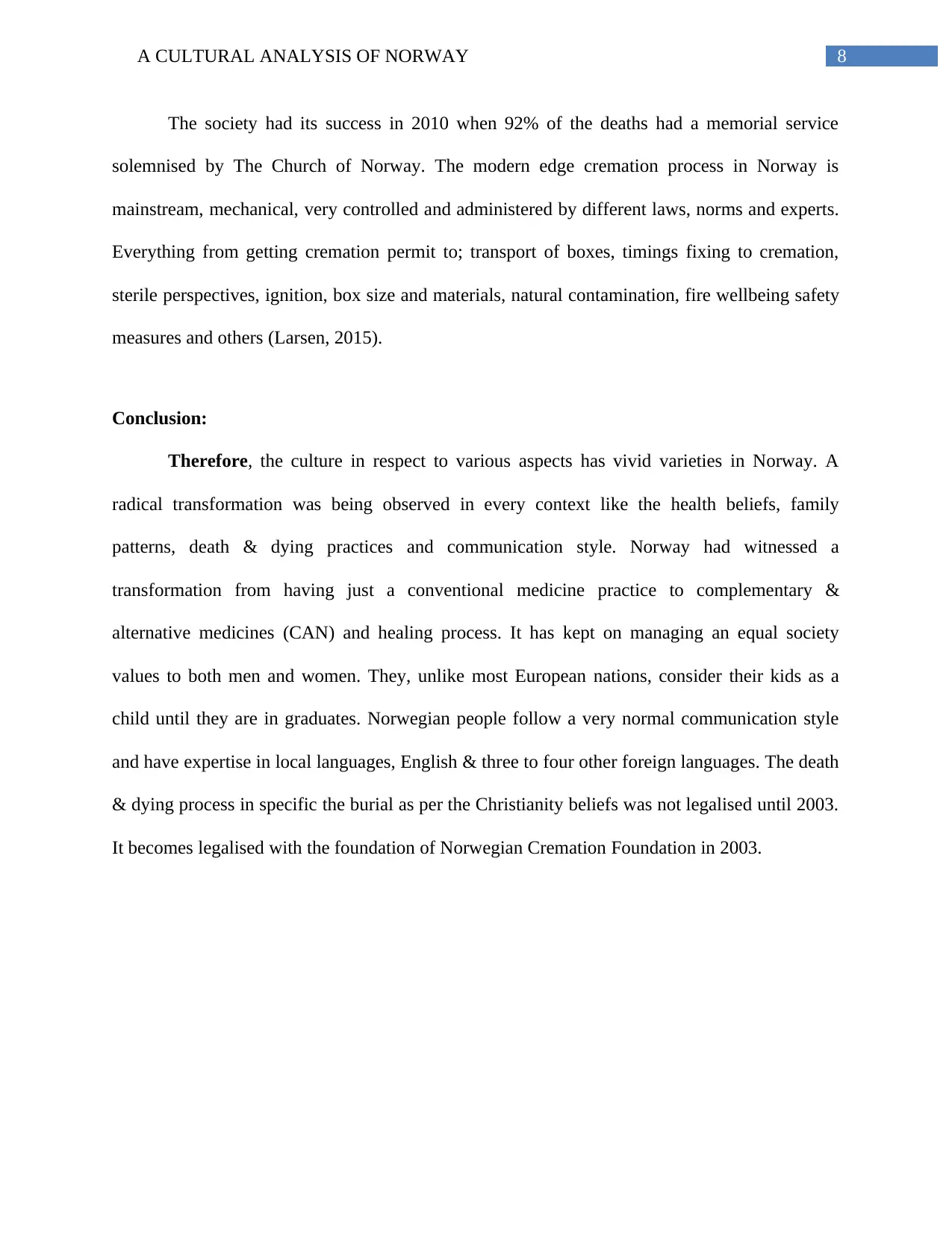
8A CULTURAL ANALYSIS OF NORWAY
The society had its success in 2010 when 92% of the deaths had a memorial service
solemnised by The Church of Norway. The modern edge cremation process in Norway is
mainstream, mechanical, very controlled and administered by different laws, norms and experts.
Everything from getting cremation permit to; transport of boxes, timings fixing to cremation,
sterile perspectives, ignition, box size and materials, natural contamination, fire wellbeing safety
measures and others (Larsen, 2015).
Conclusion:
Therefore, the culture in respect to various aspects has vivid varieties in Norway. A
radical transformation was being observed in every context like the health beliefs, family
patterns, death & dying practices and communication style. Norway had witnessed a
transformation from having just a conventional medicine practice to complementary &
alternative medicines (CAN) and healing process. It has kept on managing an equal society
values to both men and women. They, unlike most European nations, consider their kids as a
child until they are in graduates. Norwegian people follow a very normal communication style
and have expertise in local languages, English & three to four other foreign languages. The death
& dying process in specific the burial as per the Christianity beliefs was not legalised until 2003.
It becomes legalised with the foundation of Norwegian Cremation Foundation in 2003.
The society had its success in 2010 when 92% of the deaths had a memorial service
solemnised by The Church of Norway. The modern edge cremation process in Norway is
mainstream, mechanical, very controlled and administered by different laws, norms and experts.
Everything from getting cremation permit to; transport of boxes, timings fixing to cremation,
sterile perspectives, ignition, box size and materials, natural contamination, fire wellbeing safety
measures and others (Larsen, 2015).
Conclusion:
Therefore, the culture in respect to various aspects has vivid varieties in Norway. A
radical transformation was being observed in every context like the health beliefs, family
patterns, death & dying practices and communication style. Norway had witnessed a
transformation from having just a conventional medicine practice to complementary &
alternative medicines (CAN) and healing process. It has kept on managing an equal society
values to both men and women. They, unlike most European nations, consider their kids as a
child until they are in graduates. Norwegian people follow a very normal communication style
and have expertise in local languages, English & three to four other foreign languages. The death
& dying process in specific the burial as per the Christianity beliefs was not legalised until 2003.
It becomes legalised with the foundation of Norwegian Cremation Foundation in 2003.
⊘ This is a preview!⊘
Do you want full access?
Subscribe today to unlock all pages.

Trusted by 1+ million students worldwide
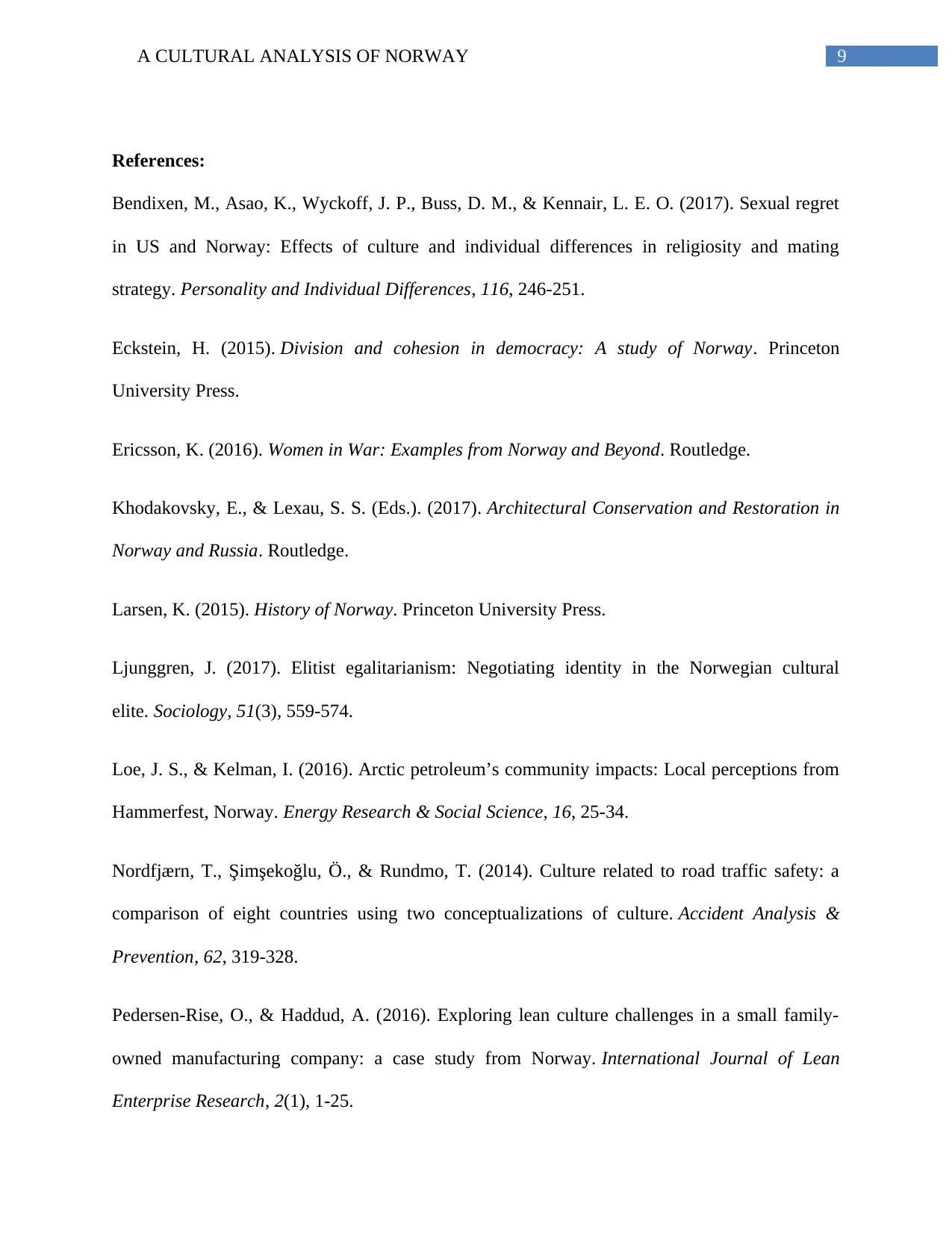
9A CULTURAL ANALYSIS OF NORWAY
References:
Bendixen, M., Asao, K., Wyckoff, J. P., Buss, D. M., & Kennair, L. E. O. (2017). Sexual regret
in US and Norway: Effects of culture and individual differences in religiosity and mating
strategy. Personality and Individual Differences, 116, 246-251.
Eckstein, H. (2015). Division and cohesion in democracy: A study of Norway. Princeton
University Press.
Ericsson, K. (2016). Women in War: Examples from Norway and Beyond. Routledge.
Khodakovsky, E., & Lexau, S. S. (Eds.). (2017). Architectural Conservation and Restoration in
Norway and Russia. Routledge.
Larsen, K. (2015). History of Norway. Princeton University Press.
Ljunggren, J. (2017). Elitist egalitarianism: Negotiating identity in the Norwegian cultural
elite. Sociology, 51(3), 559-574.
Loe, J. S., & Kelman, I. (2016). Arctic petroleum’s community impacts: Local perceptions from
Hammerfest, Norway. Energy Research & Social Science, 16, 25-34.
Nordfjærn, T., Şimşekoğlu, Ö., & Rundmo, T. (2014). Culture related to road traffic safety: a
comparison of eight countries using two conceptualizations of culture. Accident Analysis &
Prevention, 62, 319-328.
Pedersen-Rise, O., & Haddud, A. (2016). Exploring lean culture challenges in a small family-
owned manufacturing company: a case study from Norway. International Journal of Lean
Enterprise Research, 2(1), 1-25.
References:
Bendixen, M., Asao, K., Wyckoff, J. P., Buss, D. M., & Kennair, L. E. O. (2017). Sexual regret
in US and Norway: Effects of culture and individual differences in religiosity and mating
strategy. Personality and Individual Differences, 116, 246-251.
Eckstein, H. (2015). Division and cohesion in democracy: A study of Norway. Princeton
University Press.
Ericsson, K. (2016). Women in War: Examples from Norway and Beyond. Routledge.
Khodakovsky, E., & Lexau, S. S. (Eds.). (2017). Architectural Conservation and Restoration in
Norway and Russia. Routledge.
Larsen, K. (2015). History of Norway. Princeton University Press.
Ljunggren, J. (2017). Elitist egalitarianism: Negotiating identity in the Norwegian cultural
elite. Sociology, 51(3), 559-574.
Loe, J. S., & Kelman, I. (2016). Arctic petroleum’s community impacts: Local perceptions from
Hammerfest, Norway. Energy Research & Social Science, 16, 25-34.
Nordfjærn, T., Şimşekoğlu, Ö., & Rundmo, T. (2014). Culture related to road traffic safety: a
comparison of eight countries using two conceptualizations of culture. Accident Analysis &
Prevention, 62, 319-328.
Pedersen-Rise, O., & Haddud, A. (2016). Exploring lean culture challenges in a small family-
owned manufacturing company: a case study from Norway. International Journal of Lean
Enterprise Research, 2(1), 1-25.
Paraphrase This Document
Need a fresh take? Get an instant paraphrase of this document with our AI Paraphraser
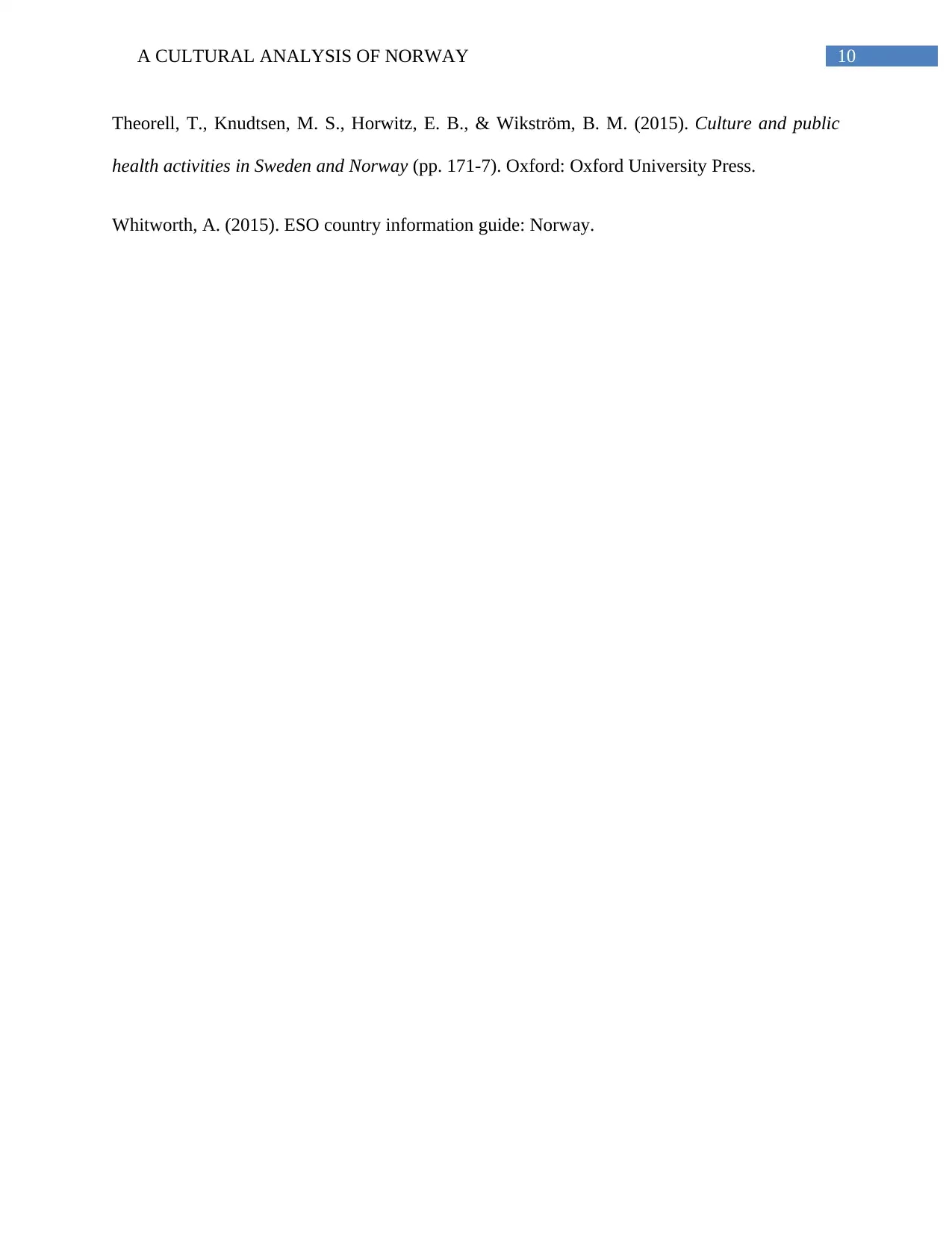
10A CULTURAL ANALYSIS OF NORWAY
Theorell, T., Knudtsen, M. S., Horwitz, E. B., & Wikström, B. M. (2015). Culture and public
health activities in Sweden and Norway (pp. 171-7). Oxford: Oxford University Press.
Whitworth, A. (2015). ESO country information guide: Norway.
Theorell, T., Knudtsen, M. S., Horwitz, E. B., & Wikström, B. M. (2015). Culture and public
health activities in Sweden and Norway (pp. 171-7). Oxford: Oxford University Press.
Whitworth, A. (2015). ESO country information guide: Norway.
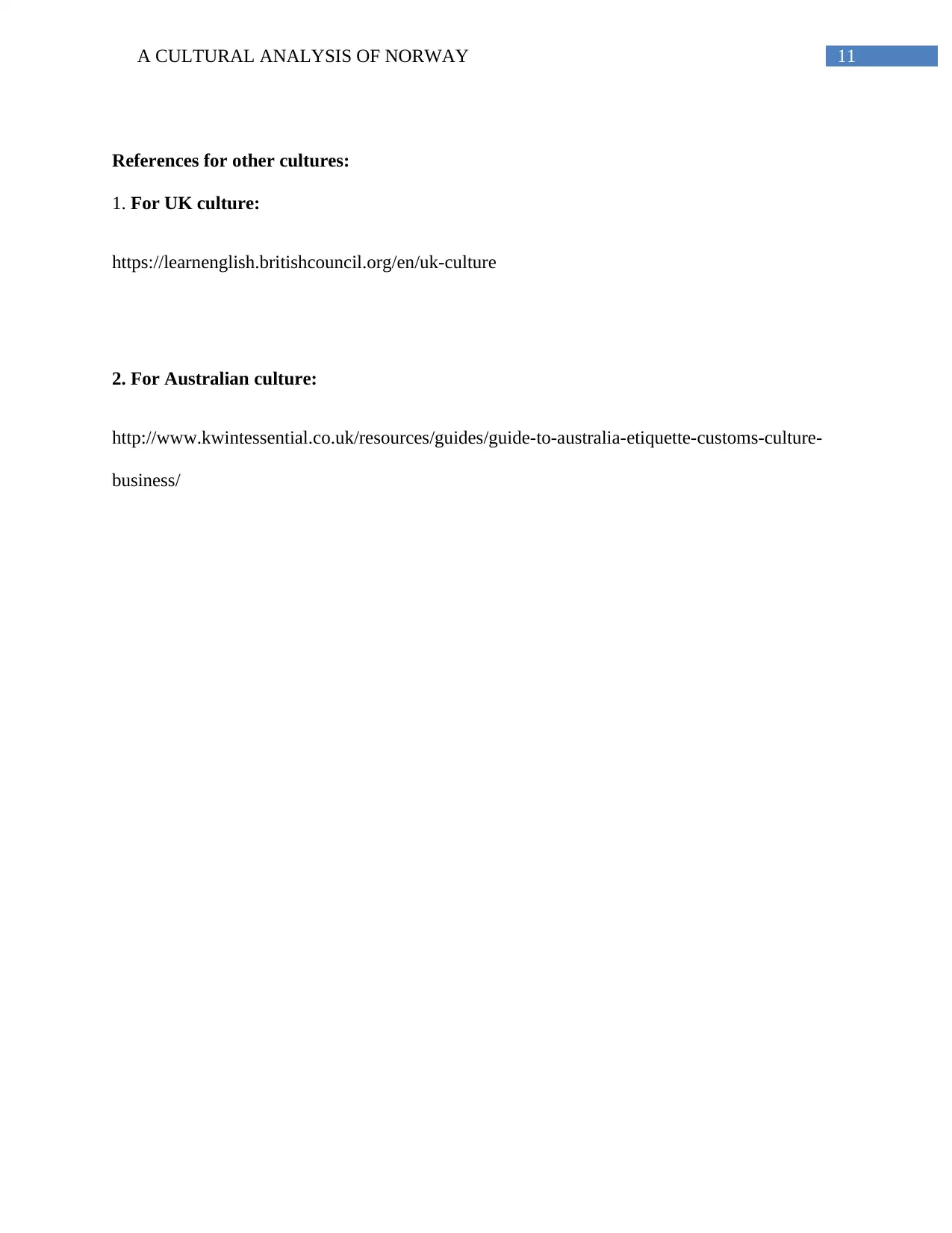
11A CULTURAL ANALYSIS OF NORWAY
References for other cultures:
1. For UK culture:
https://learnenglish.britishcouncil.org/en/uk-culture
2. For Australian culture:
http://www.kwintessential.co.uk/resources/guides/guide-to-australia-etiquette-customs-culture-
business/
References for other cultures:
1. For UK culture:
https://learnenglish.britishcouncil.org/en/uk-culture
2. For Australian culture:
http://www.kwintessential.co.uk/resources/guides/guide-to-australia-etiquette-customs-culture-
business/
⊘ This is a preview!⊘
Do you want full access?
Subscribe today to unlock all pages.

Trusted by 1+ million students worldwide
1 out of 12
Related Documents
Your All-in-One AI-Powered Toolkit for Academic Success.
+13062052269
info@desklib.com
Available 24*7 on WhatsApp / Email
![[object Object]](/_next/static/media/star-bottom.7253800d.svg)
Unlock your academic potential
Copyright © 2020–2025 A2Z Services. All Rights Reserved. Developed and managed by ZUCOL.





